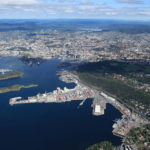
Short sea shipping services that are needed along the Norwegian coast are challenged by low volumes, multiple port calls and competition from liner companies. Thus, the country seeks a new port strategy for the future
Traditional port costs, with respect to handling cargo, port dues and te[ds_preview]rminal operations, often exceed 30% of total door-to-door distribution costs. Consequently, the Norwegian government commissioned a report asking for recommendations to the country’s future port strategy. Researchers of Molde University College, Norway, and Edinburgh Napier University, United Kingdom, presented their findings at the 2016 IAME conference in Hamburg, giving an insight into the state of Norwegian port and cargo distribution system.
The port of Oslo is by far the largest port in terms of container throughput (2003–2014), with over 210,000 TEU handled in 2014. In addition, there are several ports that are serving Eastern Norway and the greater Oslo region: Borg, Moss, Drammen, Larvik and Grenland. Ships calling these ports also call the southern port of Kristiansand. Norway can be split into Oslo, Oslo region, western and northern ports, with a low share of container traffic in the north. The ten biggest ports hold 85% of the country’s container market. Oslo alone has a market share of 29%, followed by Larvik and Ålesund (9% each). While there is a sharp increase in growth for Oslo region ports in 2008, at the same time there is a decrease for Oslo. Levels for both fall distinctively in 2009 likely as a result of the financial crisis. The same trend shows again from 2012 and onwards. When the Oslo region increases sharply, the port of Oslo decreases and has stabilized at lower levels. Therefore a key point to understand is why the Oslo region ports are able to win the competition with a much bigger port and absorb the entire growth from 2012–2014. There is no capacity problem in Oslo and indeed the port recently has commenced a significant expansion of capacity for containers.
At national level, there is a clear progression towards port concentration from 2003 to 2008 and then a deconcentration towards 2014. This is also the case in the East of the country. There is a different story in Western Norway, with a continuing deconcentration across the time period, starting very slowly and then increasing in recent years. Therefore, Norway conforms to the predictions that port systems move towards concentration then deconcentration.
To understand the dynamics of port choice, a number of shipping companies were interviewed. While transport time is a key factor for port choice this seems not to be the case for shipping lines serving the Norwegian market. It is not time that is critical, but frequency. Cargo volume is a dominant port selection criterion. Even small volumes can influence shipping lines decisions in a feeder system. Generally, the relatively low cargo volumes characterizing these port systems also cause regional markets to quickly reach their saturation point. The degree of competition at a port is an important factor evaluated by shipping lines before deciding to call a port or not.
Several reasons can be found to why Oslo region ports have grown at the expense of the port of Oslo. First of all, there is the trend of production and logistical hubs being relocated to other areas in the region. Other issues such as inadequate railway connections and higher port charges may also have had an influence. One important aspect underlined by interviewed shipping companies, is that bigger ports may not adjust as easily to the requirements of shipping lines in terms of flexibility and implementing new customer-oriented solutions, as they think secondary ports may not pose a real threat. The port of Oslo is obviously a case that shows that any player operating in a tough and competitive market has to be vigilant, especially in times when margins for shipping lines are pressured.
Obstacles to growth
Regarding obstacles to growth for Western and Northern ports, volume and directional imbalance emerge as a challenge. Smaller cargo volumes destined for Western Norway makes shippers unable to fully utilize their capacity. The disproportion of government subsidies in favor of railway infrastructure, causes railway freight rates to be so low that cargo destined for the West and the North go through the Oslo region ports. Specifically for ports in Northern Norway weekly routes and high feeder transshipment costs limit growth. Furthermore, the road network from Eastern Norway to the West and North has been considerably upgraded making these markets more accessible. On the contrary, the road infrastructure in the West still awaits advancement. Altogether, these factors put constraints on a hub port in Western Norway for the time being. However, the government has stated that the road network in the West will be free of ferry connections within 20 years which will effectively reduce the time of travel between the biggest coastal cities of Stavanger and Bergen by 50%. Upgraded road network accompanied by population growth in these cities should increase the likelihood of a hub in the West.
A port concentration might impose costs through extra cargo handling and longer door-to-door distances which could not be offset by economies of scale savings in container handling. For shortsea operators it also bears the risk of competition from major shipping lines introducing their own ships to Norwegian ports. Hub and spoke principles have not really materialized in the present Norwegian port system, the researchers found. The obstacle seems to be that all ports want to have direct connections to Continental hubs. A crucial matter is to invest into intermodal short sea-rail services in order to prevent road transport from capturing volume.
Need for concentration
The majority of shipping companies operating in Norway see a need for port concentration. A regionalized model (specialized ports within natural regions under a single governance structure) would probably be the most feasible path since the focus is turned away from closing ports into a more constructive way of organizing the port system. As a result, the likely scenario would be benefits from economies of scale through container handling and larger vessels, which would attract more volume to short sea shipping services, allowing higher frequency of service, which in turn would cause even more cargo flows to go through ports. Attracting cargo is a crucial matter for feeder systems such as the Norwegian.
Implementing a hub and spoke principles to a feeder port system is difficult. Since volumes are thin, many ports feel the need of offering a wide range of services in order to stay in the competition. The lack of specialization inflicts a cost which is held by the shipping lines which in turn need to increase the freight rate. The end of this cycle is decreased competitiveness for the local businesses as customers of short sea services and short sea shipping as a transport mode.
The researchers propose a »centralization through regionalization« model to port concentration. For port systems similar to the Norwegian, which primarily involve public ownership, an alternative approach to port concentration could be the government taking a leading role, appointing which ports should be hubs and which to be spokes or simply reducing the number of ports. However, that would imply a path which would involve conflicts mentioned above.


















